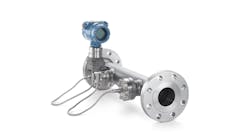An NIST invention may help purify a process for making semiconductors used in devices such as light-emitting diodes (LEDs).
Purity of ingredients is a constant concern for the semiconductor industry, because a mere trace of contaminants can damage or ruin tiny devices. In a step toward solving a long-standing problem in semiconductor manufacturing, scientists at JILA and collaborators have used their unique version of a "fine-toothed comb" to detect minute traces of contaminant molecules in the arsine gas used to make a variety of photonics devices.
JILA is a joint institute of the National Institute of Standards and Technology (NIST) and the University of Colorado at Boulder (CU). The research was conducted with collaborators from NIST’s Boulder campus and Matheson Tri-Gas (Longmont, Colo.).
The research, described in a new paper,* used an NIST/CU invention called cavity-enhanced direct frequency comb spectroscopy (CE-DFCS).** It consists of an optical frequency comb — a tool for accurately generating different colors, or frequencies, of light — adapted to analyze the quantity, structure and dynamics of various atoms and molecules simultaneously. The technique offers a unique combination of speed, sensitivity, specificity and broad frequency coverage.
The semiconductor industry has long struggled to find traces of water and other impurities in arsine gas used in manufacturing of III-V semiconductors for light-emitting diodes (LEDs), solar-energy cells and laser diodes for DVD players. The contaminants can alter a semiconductor’s electrical and optical properties. For instance, water vapor can add oxygen to the material, reducing device brightness and reliability. Traces of water are hard to identify in arsine, which absorbs light in a complex, congested pattern across a broad frequency range. Most analytical techniques have significant drawbacks, such as large and complex equipment or a narrow frequency range.
The JILA comb system, previously demonstrated as a "breathalyzer" for detecting disease***, was upgraded recently to access longer wavelengths of light, where water strongly absorbs and arsine does not, to better identify the water. The new paper describes the first demonstration of the comb system in an industrial application.
* K.C. Cossel, F. Adler, K.A. Bertness, M.J. Thorpe, J. Feng, M.W. Raynor, J. Ye. 2010. Analysis of Trace Impurities in Semiconductor Gas via Cavity-Enhanced Direct Frequency Comb Spectroscopy. Applied Physics B. Published online July 20.
** U.S. Patent number 7,538,881: Sensitive, Massively Parallel, Broad-Bandwidth, Real-Time Spectroscopy, issued in May 2009, NIST docket number 06-004, CU Technology Transfer case number CU1541B. Licensing rights have been consolidated in CU.
*** See "Optical ‘Frequency Comb’ Can Detect the Breath of Disease", in NIST Tech Beat Feb 19, 2008, at www.nist.gov/public_affairs/techbeat/tb2008_0219.htm#comb.


